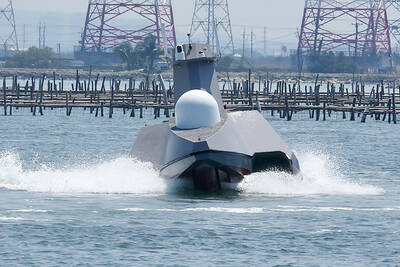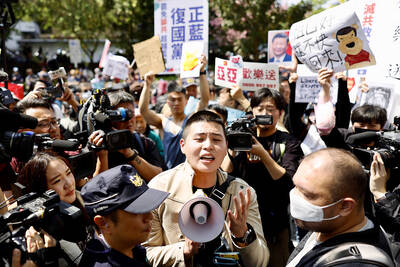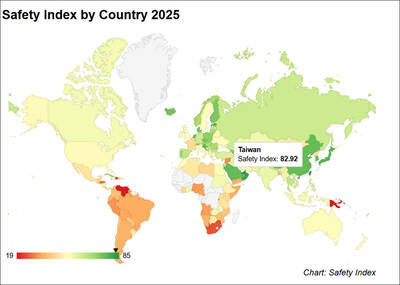Two Chinese military surveillance aircraft were monitored as they flew east of Taiwan yesterday, marking the third time this month that Chinese military planes were detected near the nation, the Ministry of National Defense said.
Two Chinese People’s Liberation Army (PLA) Shaanxi Y-8 aircraft flew northeast through the Bashi Channel to the south, but remained outside of Taiwan’s air defense identification zone (ADIZ), the ministry said.
They later flew over the Miyako Strait, accompanied by two Sukhoi Su-30 fighter jets, before returning to their base in China, it added.
It was the latest in a series of Chinese military activities near Taiwan since last month.
On Wednesday, a Y-8 aircraft was detected flying over the western Pacific Ocean, through the Miyako Strait and into the East China Sea, while on Aug. 5, a group of Chinese Xian H-6K bombers and Y-8 aircraft were seen near Taiwan’s ADIZ.
On July 25, a Xian H-6K bomber flew close to Taiwan’s ADIZ, passing through the Bashi Channel and the Miyako Strait before returning to Chinese airspace, the ministry said.
On July 20, Taiwan scrambled fighter jets as eight H-6K bombers and Y-8 aircraft flew past its east and west coasts, but remained in international airspace.
The Miyako Strait, which lies between the Japanese islands of Miyako and Okinawa, is part of Japan’s exclusive economic zone, but includes a narrow band of international waters and airspace.
The ministry said the maneuvers have been closely monitored.
China has yet to comment on the drills, but its air force has carried out several rounds of long-distance training exercises around Taiwan and southern Japanese islands in recent months.
The frequency at which Chinese military aircraft have been circling the nation is a signal that Beijing intends to make such flights routine, National Taiwan University associate professor of political science Chen Shih-min (陳世民) said yesterday.
It should be expected that Chinese aircraft are to inch closer to the nation’s ADIZ and some might begin gathering intelligence, he said, adding that the PLA judges that Taiwan cannot counter the flights, as military action is considered an outright impossibility.
The flights also serve to show the PLA’s ability to conduct operations within its sovereign claims at will and convince the world that Taiwan is a part of China, he added.
Beijing might believe that the cross-strait political climate gives it no other option to pressure Tsai Ing-wen’s (蔡英文) administration than to show force, he said.
Although Beijing did not find such measures necessary during former president Ma Ying-jeou’s (馬英九) administration, it could be concerned that given time, the nation’s continued independence might become a fait accompli, he said.
Any development in that direction would bode ill for Chinese President Xi Jinping (習近平) at a time when the National Congress of the Chinese Communist Party (CCP) is close at hand, Chen said.
Internal struggles are flaring up ahead of the congress and Xi might have sought to relieve pressures from the hawkish factions through an ostentatious display, Chen said.
The government must register a protest with the international community against any further provocations from Beijing to remind other nations of the situation’s gravity, he said.
Additional reporting by Reuters

ENDEAVOR MANTA: The ship is programmed to automatically return to its designated home port and would self-destruct if seized by another party The Endeavor Manta, Taiwan’s first military-specification uncrewed surface vehicle (USV) tailor-made to operate in the Taiwan Strait in a bid to bolster the nation’s asymmetric combat capabilities made its first appearance at Kaohsiung’s Singda Harbor yesterday. Taking inspiration from Ukraine’s navy, which is using USVs to force Russia’s Black Sea fleet to take shelter within its own ports, CSBC Taiwan (台灣國際造船) established a research and development unit on USVs last year, CSBC chairman Huang Cheng-hung (黃正弘) said. With the exception of the satellite guidance system and the outboard motors — which were purchased from foreign companies that were not affiliated with Chinese-funded

PERMIT REVOKED: The influencer at a news conference said the National Immigration Agency was infringing on human rights and persecuting Chinese spouses Chinese influencer “Yaya in Taiwan” (亞亞在台灣) yesterday evening voluntarily left Taiwan, despite saying yesterday morning that she had “no intention” of leaving after her residence permit was revoked over her comments on Taiwan being “unified” with China by military force. The Ministry of the Interior yesterday had said that it could forcibly deport the influencer at midnight, but was considering taking a more flexible approach and beginning procedures this morning. The influencer, whose given name is Liu Zhenya (劉振亞), departed on a 8:45pm flight from Taipei International Airport (Songshan airport) to Fuzhou, China. Liu held a news conference at the airport at 7pm,

Taiwan was ranked the fourth-safest country in the world with a score of 82.9, trailing only Andorra, the United Arab Emirates and Qatar in Numbeo’s Safety Index by Country report. Taiwan’s score improved by 0.1 points compared with last year’s mid-year report, which had Taiwan fourth with a score of 82.8. However, both scores were lower than in last year’s first review, when Taiwan scored 83.3, and are a long way from when Taiwan was named the second-safest country in the world in 2021, scoring 84.8. Taiwan ranked higher than Singapore in ninth with a score of 77.4 and Japan in 10th with

GRIDLOCK: The National Fire Agency’s Special Search and Rescue team is on standby to travel to the countries to help out with the rescue effort A powerful earthquake rocked Myanmar and neighboring Thailand yesterday, killing at least three people in Bangkok and burying dozens when a high-rise building under construction collapsed. Footage shared on social media from Myanmar’s second-largest city showed widespread destruction, raising fears that many were trapped under the rubble or killed. The magnitude 7.7 earthquake, with an epicenter near Mandalay in Myanmar, struck at midday and was followed by a strong magnitude 6.4 aftershock. The extent of death, injury and destruction — especially in Myanmar, which is embroiled in a civil war and where information is tightly controlled at the best of times —